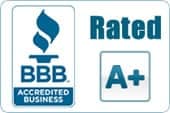Plastic water pipes have been around for quite a long time, and the quest for new, improved, innovative technology has introduced several “new” types of piping throughout the years. With all the different kinds of plastic piping that are available, or are no longer available but still found in many homes and commercial buildings, knowing which may be suitable for a particular application can be a challenge.
In this article, we will be taking a look at the more common types of plastic pipes, and their uses.
Most Common Plastic Pipe Types
ABS – ABS is not really a “water pipe” per se, but it is mentioned here because many people do not know that. ABS pipe is actually very sturdy pipe, but is used in drain/waste applications only. It is not pressure rated, and is therefore not for use as a water supply pipe.
Schedule 20 PVC – This is that really thin PVC pipe that you see in sprinkler systems some times. It is not recommended on any water system that maintains pressure. It is fine to run from your irrigation valve to your sprinkler heads… just be careful you don’t break them.
Schedule 40 PVC – This is the PVC most people are familiar with. It is white and has fairly thick pipe walls. This can be used outside, and underground for water supply pipes. It does have a tendency to break easily after age makes it brittle, and freezes pretty easily, so we do not really recommend using it for a water main. It cannot be used inside a home or commercial building, and cannot be used for hot water.
Schedule 80 PVC – This is a stronger version of PVC that has a thicker wall. It is grey in color, and can be used indoors, although considering the higher cost, and the fact that it is more difficult to work with than many other materials, there are much better alternatives for most residential applications.
CPVC – Many people think that CPVC and schedule 80 PVC are the same. They are not. CPVC actually comes in both schedule 40 and schedule 80. Its main difference is that it is chlorinated, which makes it more resistant to heat. It is actually most commonly used in commercial processed piping set-ups.
Poly-pipe – This includes polybutylene and polypropylene pipes (PVC is actually Polyvinyl Chloride) that many people had installed for their main water service in their homes. Due to the fact that they are easily punctured and have had a myriad of connection problems, it is recommended that you do not use either of these types of pipes, and if you find that you already have a water main that is either of these, you get it replaced. The telltale signs are that they are usually blue or black, are not straight (they are flexible) and are often more oval than round.
Qest pipe – Quest piping (a brand of polybutylene) was an attempt, many years ago, to make a good, cheap alternative for indoor piping. They have been the subject of many lawsuits due to the fact that the connectors fail, and cause leaks. Most homes by now have had their Qest pipes replaced with copper or PEX. If you have not yet done so, you should.
PEX – PEX pipe is a cross-linked polyethylene pipe that is a semi recent addition to the plastic water pipe world. Although past failures of plastic water piping have left many skeptics, PEX does look promising. There are a couple of different types of PEX piping whose major differences are the method by which they are connected. It is allowed for hot or cold water systems, is a food grade plastic, and so far seems to hold up well to time.
One thing to note is that, unlike most plastic pipes, the material is actually quite pricey, as are the connectors. They are, however, much faster to work with, so the labor costs for a large job (such as a repipe) is much less than with a copper repipe.
That about covers it, as far as plastic water pipes are concerned. If you have any more questions about plastic water pipes, you know who to call right? Yup… Call Allstar Plumbing!




